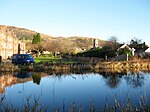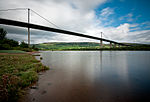St Patrick's Rock
Christian folkloreChristian missionaries in IrelandErskine, RenfrewshireLandforms of RenfrewshireMedieval legends ... and 2 more
Northern Brythonic saintsRomano-British saints

St Patrick's Rock or St Patrick's Stone is located in the River Clyde (NS461724) close to the Erskine Bridge and the old Erskine Ferry on the Renfrewshire side of the river. It is reputedly the location from which the 16 year old Saint Patrick was kidnapped by Irish pirates whilst he was fishing. The rock is covered at high tide and it is also the location of a navigation light known as St Patrick's Light.
Excerpt from the Wikipedia article St Patrick's Rock (License: CC BY-SA 3.0, Authors, Images).St Patrick's Rock
Erskine Ferry Road,
Geographical coordinates (GPS) Address Nearby Places Show on map
Geographical coordinates (GPS)
| Latitude | Longitude |
|---|---|
| N 55.920247 ° | E -4.464181 ° |
Address
Erskine Bridge
Erskine Ferry Road
G60 5DT , Mountblow
Scotland, United Kingdom
Open on Google Maps









